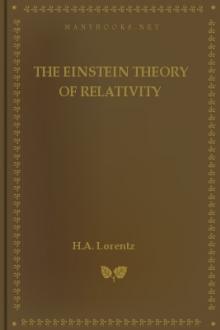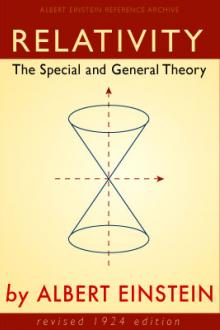The Einstein Theory of Relativity, H. A. Lorentz [great novels to read TXT] 📗

- Author: H. A. Lorentz
- Performer: -
Book online «The Einstein Theory of Relativity, H. A. Lorentz [great novels to read TXT] 📗». Author H. A. Lorentz
(3) In the excitement of this sensational verification, there has been a tendency to overlook the third experimental test to which Einstein's theory was to be subjected. If his theory is correct as it stands, there ought, in a gravitational field, to be a displacement of the lines of the spectrum towards the red. No such page 23effect has been discovered. Spectroscopists maintain that, so far as can be seen at present, there is no way of accounting for this failure if Einstein's theory in its present form is assumed. They admit that some compensating cause may be discovered to explain the discrepancy, but they think it far more probable that Einstein's theory requires some essential modification. Meanwhile, a certain suspense of judgment is called for. The new law has been so amazingly successful in two of the three tests that there must be some thing valid about it, even if it is not exactly right as yet.
Einstein's theory has the very highest degree of aesthetic merit: every lover of the beautiful must wish it to be true. It gives a vast page 24unified survey of the operations of nature, with a technical simplicity in the critical assumptions which makes the wealth of deductions astonishing. It is a case of an advance arrived at by pure theory: the whole effect of Einstein's work is to make physics more philosophical (in a good sense), and to restore some of that intellectual unity which belonged to the great scientific systems of the seventeenth and eighteenth centuries, but which was lost through increasing specialization and the overwhelming mass of detailed knowledge. In some ways our age is not a good one to live in, but for those who are interested in physics there are great compensations. page 25
The Einstein Theory of RelativityA Concise Statement by Prof. H. A. Lorentz, of the University of Leyden
The total eclipse of the sun of May 29, resulted in a striking confirmation of the new theory of the universal attractive power of gravitation developed by Albert Einstein, and thus reinforced the conviction that the defining of this theory is one of the most important steps ever taken in the domain of natural science. In response to a request by the editor, I will attempt to contribute something to its page 26general appreciation in the following lines.
For centuries Newton's doctrine of the attraction of gravitation has been the most prominent example of a theory of natural science. Through the simplicity of its basic idea, an attraction between two bodies proportionate to their mass and also proportionate to the square of the distance; through the completeness with which it explained so many of the peculiarities in the movement of the bodies making up the solar system; and, finally, through its universal validity, even in the case of the far-distant planetary systems, it compelled the admiration of all.
But, while the skill of the mathematicians was devoted to making page 27more exact calculations of the consequences to which it led, no real progress was made in the science of gravitation. It is true that the inquiry was transferred to the field of physics, following Cavendish's success in demonstrating the common attraction between bodies with which laboratory work can be done, but it always was evident that natural philosophy had no grip on the universal power of attraction. While in electric effects an influence exercised by the matter placed between bodies was speedily observed—the starting-point of a new and fertile doctrine of electricity—in the case of gravitation not a trace of an influence exercised by intermediate matter could ever be discovered. It was, and remained, inaccessible and page 28unchangeable, without any connection, apparently, with other phenomena of natural philosophy.
Einstein has put an end to this isolation; it is now well established that gravitation affects not only matter, but also light. Thus strengthened in the faith that his theory already has inspired, we may assume with him that there is not a single physical or chemical phenomenon—which does not feel, although very probably in an unnoticeable degree, the influence of gravitation, and that, on the other side, the attraction exercised by a body is limited in the first place by the quantity of matter it contains and also, to some degree, by motion and by the physical and chemical condition in which it moves. page 29
It is comprehensible that a person could not have arrived at such a far-reaching change of view by continuing to follow the old beaten paths, but only by introducing some sort of new idea. Indeed, Einstein arrived at his theory through a train of thought of great originality. Let me try to restate it in concise terms. page 30
The Earth as a Moving CarEveryone knows that a person may be sitting in any kind of a vehicle without noticing its progress, so long as the movement does not vary in direction or speed; in a car of a fast express train objects fall in just the same way as in a coach that is standing still. Only when we look at objects outside the train, or when the air can enter the car, do we notice indications of the motion. We may compare the earth with such a moving vehicle, which in its course around the sun has a remarkable speed, of which the direction and velocity during a considerable period of time may be regarded as page 31constant. In place of the air now comes, so it was reasoned formerly, the ether which fills the spaces of the universe and is the carrier of light and of electro-magnetic phenomena; there were good reasons to assume that the earth was entirely permeable for the ether and could travel through it without setting it in motion. So here was a case comparable with that of a railroad coach open on all sides. There certainly should have been a powerful “ether wind” blowing through the earth and all our instruments, and it was to have been expected that some signs of it would be noticed in connection with some experiment or other. Every attempt along that line, however, has remained fruitless; all the phenomena examined were page 32evidently independent of the motion of the earth. That this is the way they do function was brought to the front by Einstein in his first or “special” theory of relativity. For him the ether does not function and in the sketch that he draws of natural phenomena there is no mention of that intermediate matter.
If the spaces of the universe are filled with an ether, let us suppose with a substance, in which, aside from eventual vibrations and other slight movements, there is never any crowding or flowing of one part alongside of another, then we can imagine fixed points existing in it; for example, points in a straight line, located one meter apart, points in a level plain, like the angles or squares on a chess board extending page 33out into infinity, and finally, points in space as they are obtained by repeatedly shifting that level spot a distance of a meter in the direction perpendicular to it. If, consequently, one of the points is chosen as an “original point” we can, proceeding from that point, reach any other point through three steps in the common perpendicular directions in which the points are arranged. The figures showing how many meters are comprized in each of the steps may serve to indicate the place reached and to distinguish it from any other; these are, as is said, the “co-ordinates” of these places, comparable, for example, with the numbers on a map giving the longitude and latitude. Let us imagine that each point has noted page 34upon it the three numbers that give its position, then we have something comparable with a measure with numbered subdivisions; only we now have to do, one might say, with a good many imaginary measures in three common perpendicular directions. In this “system of co-ordinates” the numbers that fix the position of one or the other of the bodies may now be read off at any moment.
This is the means which the astronomers and their mathematical assistants have always used in dealing with the movement of the heavenly bodies. At a determined moment the position of each body is fixed by its three co-ordinates. If these are given, then one knows also the common distances, as well as the page 35angles formed by the connecting lines, and the movement of a planet is to be known as soon as one knows how its co-ordinates are changing from one moment to the other. Thus the picture that one forms of the phenomena stands there as if it were sketched on the canvas of the motionless ether. page 36
Einstein's DepartureSince Einstein has cut loose from the ether, he lacks this canvas, and therewith, at the first glance, also loses the possibility of fixing the positions of the heavenly bodies and mathematically describing their movement—i.e., by giving comparisons that define the positions at every moment. How Einstein has overcome this difficulty may be somewhat elucidated through a simple illustration.
On the surface of the earth the attraction of gravitation causes all bodies to fall along vertical lines, and, indeed, when one omits the resistance of the air, with an equally page 37accelerated movement; the velocity increases in equal degrees in equal consecutive divisions of time at a rate that in this country gives the velocity attained at the end of a second as 981 centimeters (32.2 feet) per second. The number 981 defines the “acceleration in the field of gravitation,” and this field is fully characterized by that single number; with its help we can also calculate the movement of an object hurled out in an arbitrary direction. In order to measure the acceleration we let the body drop alongside of a vertical measure set solidly on the ground; on this scale we read at every moment the figure that indicates the height, the only co-ordinate that is of importance in this rectilinear movement. Now we ask page 38what would we be able to see if the measure were not bound solidly to the earth, if it, let us suppose, moved down or up with the place where it is located and where we are ourselves. If in this case the speed were constant, then, and this is in accord with the special theory of relativity, there would be no motion observed at all; we should again find an acceleration of 981 for a falling body. It would be different if the measure moved with changeable velocity.
If it went down with a constant acceleration of 981 itself, then an object could remain permanently at the same point on the measure, or could move up or down itself alongside of it, with constant speed. The relative movement of the body with page 39regard to the measure should be without acceleration, and if we had to judge only by what we observed in the spot where we were and which was





Comments (0)